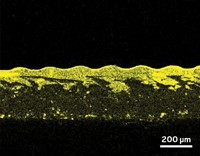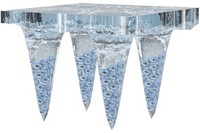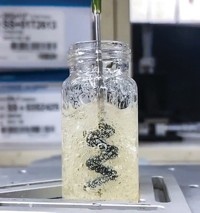Advertisement
Grab your lab coat. Let's get started
Welcome!
Welcome!
Create an account below to get 6 C&EN articles per month, receive newsletters and more - all free.
It seems this is your first time logging in online. Please enter the following information to continue.
As an ACS member you automatically get access to this site. All we need is few more details to create your reading experience.
Not you? Sign in with a different account.
Not you? Sign in with a different account.
ERROR 1
ERROR 1
ERROR 2
ERROR 2
ERROR 2
ERROR 2
ERROR 2
Password and Confirm password must match.
If you have an ACS member number, please enter it here so we can link this account to your membership. (optional)
ERROR 2
ACS values your privacy. By submitting your information, you are gaining access to C&EN and subscribing to our weekly newsletter. We use the information you provide to make your reading experience better, and we will never sell your data to third party members.
3-D Printing
Oil and water emulsion supports 3-D printing of liquid inks
Packed oil droplets can withstand ultraviolet and heat curing of soft 3-D printed parts
by Lakshmi Supriya, special to C&EN
June 26, 2020
The ability to 3-D print liquid inks and soft materials—such as polymers, colloidal solutions, and even living cells—is useful for tissue engineering, prosthetics, and medical applications. A new oil and water emulsion—which has the consistency of a solid and just the right amount of give—holds the inks in place and retains the desired shape until the printed structures are cured (ACS Appl. Mater. Interfaces 2020, DOI: 10.1021/acsami.0c04121). To remove the printed object, the emulsion can simply be rinsed away with water. Plus, the water and oil can be easily separated and reused, making the process more environmentally friendly.
Doing 3-D printing with liquid inks generally involves injecting them into a material that helps maintain the structure’s shape until it sets. Existing methods use tiny hydrogel particles as the support material. But the ultraviolet radiation or high temperatures needed to cure the liquid inks into 3-D solids can damage or destroy the hydrogels and may cause the printed parts to sag or fall apart.
Ssu-Wei Hu and Heng-Kwong Tsao of National Central University, and Yu-Jane Sheng of National Taiwan University, thought an emulsion could be an alternative to current hydrogel materials. A good supporting medium needs to behave like a liquid during writing, separating easily as the print head moves through it and rapidly recovering from any distortions made during writing. In addition, the medium needs to be solid enough to support the printed part. Emulsions possess both these characteristics, Hu says.
The researchers prepared an emulsion consisting of about 90% silicone oil droplets by weight in water, along with a surfactant. The high number of oil droplets jammed together makes the emulsion almost like a solid. The researchers then printed a spiral-shaped structure by moving the needle of the 3-D printer through the droplets while injecting a silicone elastomer ink. They used UV light or thermal curing to solidify the part.
The emulsion withstood temperatures up to 85 °C and did not degrade during UV curing like hydrogel support mediums do. The researchers used the same emulsion six times without any loss in its properties. According to the authors, they can print parts of any size, as long as they have the correct size printing needle and sufficient supporting media. Also, the team is testing other emulsions, such as decane in water, to find ones with even better heat stability.
“The use of packed emulsions as a 3-D printing support medium is an elegant approach,” says Thomas E. Angelini of the University of Florida, who was not part of the study. “I am shocked that somebody hasn’t already done it, so the authors deserve praise for being the first group to leverage such a widely used and well understood phase of soft matter in a new application.”
Emulsions can be made at industrial scales, which should keep their cost low, Angelini says. However, for widespread use, the method will need to be further refined to allow for smaller feature sizes and improve the quality of the printed structures, he adds.
UPDATE
This story, its deck, and the photo's caption were updated on June 29, 2020, to clarify that the emulsion shown in the video is of decane, not silicone oil, in water.





Join the conversation
Contact the reporter
Submit a Letter to the Editor for publication
Engage with us on Twitter